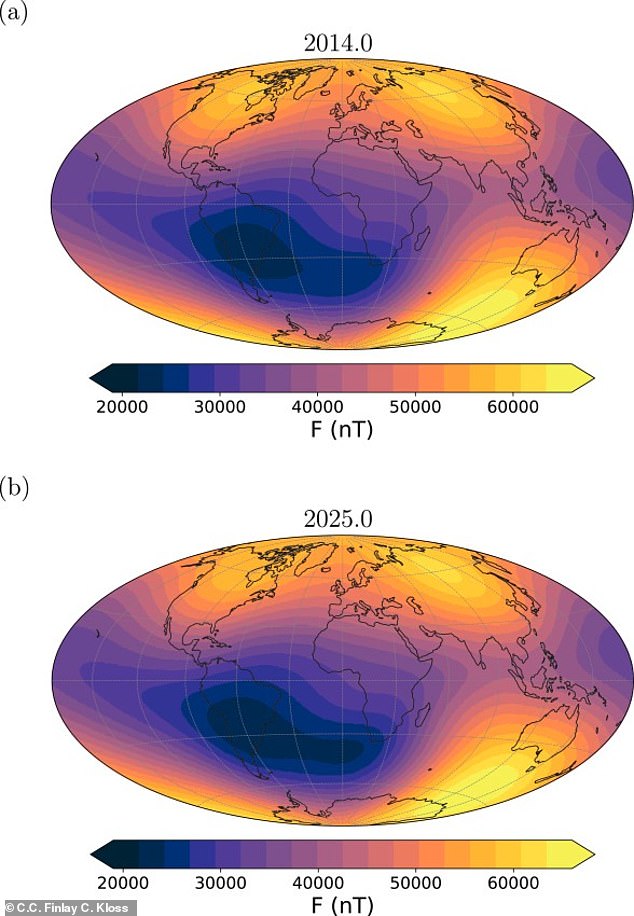Scientists have discovered that a ‘weak spot’ in Earth’s magnetic field is growing at an alarming rate.
Known as the South Atlantic Anomaly (SAA), the region has expanded by an area nearly twice the size of Texas since 2014, and it is also slowly shifting westward toward Africa, according to a new study released on Monday.
The SAA has increased by up to 25 percent, as it moves about 14 miles west each year.
The expansion and movement are the result of turbulent flows of molten iron in Earth’s outer core, which generate unusual magnetic patterns that weaken the field in this part of the planet.
The Earth’s magnetic field, created by the swirling liquid iron thousands of miles beneath the surface, acts as a protective shield against dangerous charged particles from the sun and cosmic radiation.
Scientists warned that the weakening and shifting of this shield in the SAA is not just a scientific curiosity but has real-world consequences.
The SAA poses the greatest threat to satellites passing overhead, exposing spacecraft to higher levels of radiation that can temporarily disable electronics, corrupt data, or even cause permanent damage to critical hardware.
Satellites providing GPS, communications, and weather forecasting services for the US and around the world are particularly vulnerable when they pass through the anomaly.

The SAA has increased by up to 25 percent, as it moves about 14 miles west each year since 2014
Lead author Chris Finlay, Professor of Geomagnetism at the Technical University of Denmark, said in a statement: ‘It’s changing differently towards Africa than it is near South America.
‘There’s something special happening in this region that is causing the field to weaken in a more intense way.’
While regions outside of Earth contribute to the observed magnetic field, the primary source stems from inside the planet.
The outer layer of Earth’s core is made of molten iron and nickel, located 1,800 miles below the surface.
These churning metals act like a massive generator called the ‘geodynamo,’ creating electric currents that produce the magnetic field.
But this motion isn’t constant. It fluctuates over time, and as a result, Earth’s magnetic field fluctuates too.
This, coupled with the tilt of the planet’s magnetic axis, is what produces the SAA, according to NASA.
In the southern hemisphere, weak magnetic areas under Africa are moving westward, while similar features in the mid-Atlantic are moving east.

Scientists warned the weak spot will let harmful radiation from the sun hit Earth, disrupting satellites in orbit
In the north, a strong magnetic zone under the Bering Strait is drifting west, and near Indonesia and the western Pacific, magnetic features are moving east.
These shifts are strongest near the equator, where the field is also experiencing rapid changes and oscillations.
The study, which analyzed 11 years of data from the European Space Agency’s (ESA) Swarm satellite constellation, also revealed other significant changes in Earth’s magnetic field.
In northern Canada, the area of the strong magnetic field has weakened, shrinking by 0.65 percent of Earth’s surface area.
This weakening can affect navigation systems, satellite operations, and even technologies that rely on geomagnetic calibration.
Additionally, the study found that strong magnetic flux features under the Bering Strait have shifted westward, while those beneath Indonesia and the western Pacific have moved eastward.
These movements, though invisible to most people, can influence global geomagnetic conditions and the behavior of space weather, further impacting satellites and technology infrastructure worldwide.
Scientists emphasized that the changes in Earth’s magnetic field highlight its dynamic nature.
The SAA is not static, and its continued growth underscores the importance of constant monitoring to anticipate and mitigate potential impacts.
The Swarm satellites, which have been collecting continuous magnetic field data since 2013, are providing unprecedented insight into the complex forces at work deep inside our planet.
While the average person on the ground is not directly at risk, the growing anomaly is a reminder of the delicate balance that protects life on Earth from the constant bombardment of cosmic radiation.
For satellites, astronauts, and high-altitude air travel, however, the implications are real and require careful attention.
“The South Atlantic Anomaly is a warning from Earth’s core,” Finlay said. “It shows us that our planet’s protective shield is dynamic, and changes deep below the surface can ripple all the way to space and to our daily lives.”
The discovery was made using the European Space Agency’s (ESA) Swarm satellite constellation that precisely measures the magnetic signals that stem from Earth’s core, mantle, crust and oceans, as well as from the ionosphere and magnetosphere.
This article was originally published by a www.dailymail.co.uk . Read the Original article here. .

